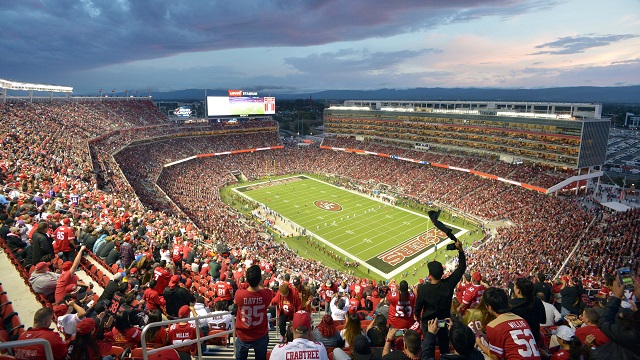New Football Stadium Leads the Way for STEM Industries
Paul Hightower, Science Content Editor at NMSI |
February 10, 2016
On February 7th, two national football franchises met to play professional sports’ largest event, Super Bowl 50 in Santa Clara, California. While the week prior is filled with team coverage, player and coach interviews, and endless analysis of game-day strategy, few talked about the most remarkable aspect of all—the new stadium.
This year’s Super Bowl was played in Levi’s Stadium, a newly built, multi-purpose venue that opened in 2014 as the football home of the San Francisco 49ers. It is an STEM marvel that seats up to 75,000 people for events ranging from the Pac-12 College Football Championship to a Grateful Dead concert; and it does all this with the stated goal of being net zero energy and environmental performance.

Levi’s Stadium is a “smart stadium,” the first professional NFL arena and one of the largest public structures to achieve Leadership in Energy & Environmental Design (LEED) Gold-level certification from the U.S. Green Building Council. At the time of its opening, the stadium achieved 44 points on the LEED scale (a minimum of 40 is required) and is improving its internal processes and efficiencies as it continues to operate.
The structure powers itself using photovoltaic energy generation from more than 1,100 solar panels installed on three pedestrian bridges and one roof deck, taking advantage of the state’s most abundant resource (good weather). This is a remarkable technological feat, as even a stadium as modern as AT&T Field, built in 2009 as the home of the Dallas Cowboys, can draw an estimated 10 megawatts of electricity from the local power grid every gameday.
Beyond power consumption, the declared top priorities of Levi’s Stadium are the value of the fan experience as well as green technology. Potable and non-potable water is recycled for purposes like irrigation and sanitation in low-flow toilets and sinks, and its playing field in drought-prone Northern California features embedded sensors for soil moisture and a species of Bermuda grass requiring only half the water of normal turf. The stadium is constructed throughout with recycled and reclaimed materials, including 100% locally reclaimed wood used in the décor of the luxury suites.
A “green roof” consisting of 27,000 square feet of natural grass is located on top of the suites as an aid to insulation that includes 40 different species of regional flora. Concessionaires that operate in the stadium are focused on locally grown ingredients and suppliers for their farm-to-table menus, and composting and recycling are high priorities. Even the site of the stadium was chosen deliberately, located to maximize sustainability and accessibility to public transportation and neighborhood bike paths.
Benefitting from the Silicon Valley culture and expertise, the “smartness” of Levi’s Stadium is not limited to just power and recycling. The entire site offers free Wi-Fi coverage to all guests—no small accomplishment given the inherent bulk of steel and concrete—and an electronic dashboard is provided that offers live stats of energy, air and water monitors. Online ordering of food and drink is made available, as are fan-friendly amenities such as downloading high-definition replays and locating your car in the parking lot.
Levi’s Stadium is leading the way in a next generation of sports arenas around the country that are taking advantage of new technologies and understanding from a variety of STEM fields. Practical, commercial applications such as these are becoming appealing and standard in an effort to develop and promote more sustainable and user-friendly structures that focus on heavy public use and consumption.